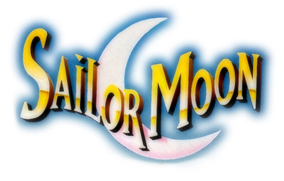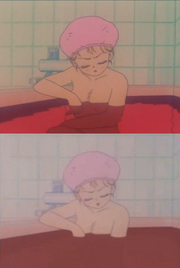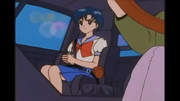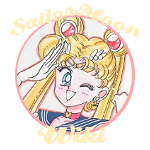
The logo for the series at the time that DiC and Cloverway had the license
This article covers every notable English version of the meta-series, including fan-subtitled versions.
Anime[]
Dubs and Licenses[]
DiC[]
DiC was the first company to own the rights to the Sailor Moon anime in North America when they won the rights to the first two seasons in 1995 after striking a deal with Bandai, which would make toys based on the series.
When they first got the series, they only aired sixty-five episodes in America and they had to cut episodes that were deemed inappropriate for children to be watching or, in the case of Death of the Sailor Guardians: The Tragic Final Battle and Usagi's Eternal Wish: A Brand New Life, merge them together and cut out specific scenes focusing on violence or sexuality.
About two years later, however, Cartoon Network, with support from General Mills-sponsored The Program Exchange, acquired the rights to air the last seventeen episodes of R nationally on American television after the series got more popular on the Toonami block. This was long after the episodes aired on YTV in Canada, and a few months after airing in limited syndication in selected U.S. markets.
Censorship, Changes, and Cuts[]

An example of one of DiC's edits. In the original scene (first image), Usagi is shown taking a bath with the water being transparent and little to no detail on her body. In the English dub (second image), the water is made opaque.
A number of changes were made in DiC's dub of the anime, with the notable ones being that character names were changed (i.e. Usagi was now called Serena) and that major plot points and elements were changed or abolished completely. They would also try to cover or edit Japanese references, in order to try to make the show seem less foreign to viewers. In the first season, some scenes from Usagi's Awakening: A Message from the Distant Past were added onto the first episode as an introduction. However, this ended up majorly spoiling the plot, as one of the scenes showed Princess Serenity, Prince Endymion, and the rest of the Sailor Team, making their identities apparent to the audience. The opening sequence also ended up doing something similar, as it showed the scene where Princess Serenity and the spirits of the Sailor Senshi are fighting against Super Beryl in the last episode of the first season.

Another example of DiC's edits, this time from their dub of A Guardian’s Friendship: Goodbye, Ami. Here, DiC edited a seatbelt onto Ami.
The opening also included a new theme song and it added in clips from other episodes as well.[1] Other changes in the first season included Zoisite's gender being changed, six episodes being cut or merged, scenes being edited or cut for time or because they were deemed inappropriate, and a large amount of slang that was seen as "hip" at the time.
The dub of the second season went through the same treatment and the only episode that was cut was The Ocean! The Island! A Vacation! A Break for the Sailor Senshi. Both seasons also included changes to transformation sequences where breast and other body lines were erased, editing and cutting to some scenes that showed violence, and the addition of the Sailor Says segment for educational and moral value.
Cloverway English Dub[]
Later on, in 2000, Cloverway Inc., Toei's international branch, bought the rights to the first anime and dubbed Pretty Soldier Sailor Moon S and Sailor Moon SuperS. Their dub of the two seasons was rushed thanks to Cartoon Network wanting Cloverway to get the dub done in several months and, as a result, both of the seasons began to air new episodes and finished airing its episodes in the same year their dubs aired (2000).
Censorship and Changes[]
Once Cloverway started dubbing the series, there were many improvements but also many downfalls. Because of the rush to complete the show in time for its summer run, there was not enough time to rescore the show, so they would just put an English version of the song to replace it (as what they did for Guardian of Love), or just completely remove the song without a replacement.
Their scripts were also much more faithful to their original ones and may also have been influenced by demand from the fans. The introduction of a TV rating system for children also helped to lessen censorship, as the show was rated TV-Y7-FV due to the amount of violence and thanks to the rules for children's television relaxing as a result of the system, the Sailor Says segment was cut out.
However, Cloverway's episodes had many mistakes and inconsistencies, which was also because of speedy production. For example, most attack names in this dub didn't retain their original DiC names. Some of these mistakes include characters forgetting their names from past seasons and attack and transformation names changing from episode to episode.
In addition to these inconsistencies, Cloverway made some major changes of their own, including the decision to change Zirconia, Tamasaburou, and Fish Eye's gender, with the two latter characters' gender being changed because of them cross-dressing (and, in Fish Eye's case, homosexuality), while the former had no reasons behind the change. Another important decision was their decision to hide Haruka and Michiru's lesbian relationship by calling them, cousins.
Changing them to being 'cousins' forced Cloverway to make edits on scenes in which they showed love for each other, and change the dialogue to hide their usual flirting with each other (and, also times, when Haruka flirted with Usagi, were also changed). This also caused Cloverway to change major plots from various episodes, such as with episode 95, in which Haruka and Michiru enter a couple of contest, but Cloverway changed it to a 'friend contest'.
Cloverway would also put the word 'cousin' in anywhere they possibly could, and they would even have people who shouldn't know this information calling them cousins.
Viz Media[]
On May 16, 2014, after their panel at Anime Central, Viz Media, a North American anime and manga distributor, announced that they licensed the rights to dub, digitally stream, sub, and release the anime on home video. Their release of the anime keeps the original Japanese names intact and that they would release all of the seasons of the anime, as well as the specials and movies. They stated that their release would have no edits.[2]
The Viz Media English dub is closer to the original Japanese scripts. They dubbed every episode including Stars season and the episodes not dubbed by DiC and/or Cloverway.
The first two episodes of the Viz Media English dub were shown at the AnimeExpo on July 5. The cast for the dub of the anime was also announced on the same day.[3][4] Finally, on September 5, Viz Media released the first twenty-three episodes of the dub on Neon Alley and Hulu.
Official Subtitled Versions[]
A.D. Vision and Pioneer[]
The official subtitled version in the A.D. Vision and Pioneer releases are uncut and use the original names, though fans have complained of minor dialogue changes.
Their subtitled version is considered to be much belated by many fans, as the first two seasons were released eight years after they had aired. By the time the official release had come out, many fans had already bought fan subtitled versions and were not willing to spend the money.
Viz Media[]
Viz had stated that they plan to release the series both subbed and dubbed on home video. They have also started to stream the subtitled version of the first anime on Neon Alley.
Viz later released the subtitled versions of the first 23 episodes onto both the U.S. and Canadian iTunes stores.[5][6]
Fansubs[]
Many fan-subs for the first anime have appeared on both tapes and online. At the time of the release of the DiC and Cloverway dubs, fansubs were popular with people who preferred the original unedited anime over the edited dubs.
Manga[]
Official Translations[]
Tokyopop and Mixx[]
Mixx Publications, now known as Tokyopop, was the first company to release and translate the entire manga series in the United States. They originally published the manga in Mixxzine and it began to be serialized bi-monthly starting in August 1997. The February 1998 issue of Mixxzine later announced that it would be compiled into a Pocket Mixx edition as well and that each book of which would correspond to the original graphic novels.
At the same time, however, Mixx revealed the launch of their new and controversial magazine, Smile. The original premise was for the magazine to be a generic girls' fashion periodical, featuring reader-sent photos of ordinary girls and their families. Later, it was announced that Sailor Moon had been slated to move to Smile, which was launched in October 1998, with the series being its major selling point.
Changes and Errors[]
Sailor Moon was Mixx's first translation, and while little was deliberately changed, many things were Americanized and lost in translation. Examples include the retention of the DiC names for all characters (albeit Usagi usually being called "Bunny") until the translation of the Infinity arc, where Sailors Uranus, Neptune, and Saturn retained their original names. However, they were mistakenly called Alex/Erica, Michelle, and Jenny at some points. Another famous error is the retranslation of a Yeats poem, which was originally an English poem translated to Japanese, into English.
Several minor characters had their names grossly mistranslated (e.g. Ptilol as "Petite Roll") and some character's names didn't make sense because of the mistranslation or because of the use of the DiC names. An example of the latter was Chibi Chibi, whose name was supposed to be based on her constant repetition of the word "Chibi," which she said because she had heard Ikuko say Chibiusa's name. In the Mixx translation, however, Chibiusa is known as "Rini". To make this work, the name is mentioned as Chibiusa like it was in the original. This move, however, made readers confused, as they didn't know who Ikuko was referring to.
Controversy[]
In July 1998, Ron Scovil, the then editor-in-chief of Mixxzine, ended his tenure and left Mixx after doing so. Shortly, he created a webpage called Eye On Mixx, which was intended to show Mixx's "true intentions." Ron had many friends and allies from the Mixx Online Messageboard, which was shut down after the launch of Smile due to fan misbehavior.
More controversy arose when "Smile" was first released. Fans who wanted to continue reading Sailor Moon and the other manga in Mixx Magazine had to get subscriptions to both periodicals, which proved to be unfortunate for those who were not teenage girls and were not interested in Smile. Because of this, fans complained about Smile magazine and made allegations that Mixx had created false accounts on their boards to support their cause and deleted negative opinions.
In November of the same year, the latest issue of Mixx magazine was released and it had many differences in comparison to it's previous issues. The magazine was thinner (albeit with the cost still the same), filled with articles on music and CDs, as well as the usual anime articles, whereas the manga itself had been flipped sideways and sized down to fit two to a page.
Less than hours after the magazine came out, somebody calling themselves "PissedFan" hacked the Mixx website. The main page was replaced with a graphic of Usagi lifting her shirt and revealing her breasts, with a message below it that says "Why are you here? Stu Levy, president of Mixx Entertainment is A MONEY GRUBBING LIAR. His sole purpose is to remove you from your money." This message was followed by a couple of links and a signature. This message was soon replaced.
About three days after the incident, Stu Levy posted a seven-page "response" to the controversy that flew around Mixx and Ron Scovil on the Mixx website. Later on, sites like Anime News Network (ANN) constantly reported the controversy, with ANN being the most notable site to do so. ANN later went on to publish a cover story that featured interviews with Stu Levy and Ron Scovil.[7]
Kodansha USA[]
Kodansha is the publisher of Sailor Moon in Japan and eventually began to release it in English themselves.
Kodansha 2011[]
On March 18, 2011, Kodansha USA released a press release about publishing a new English translation of the Sailor Moon manga and a translation of Codename: Sailor V.[8] The first volume of the Kodansha USA English translation of the Sailor Moon manga was published on September 13, 2011, while the last volume was released on July 2, 2013. The Short Stories volumes were eventually translated as well.
In all, this version of the manga comprised of 16 Volumes total. 12 covering the main arcs of Sailor Moon, 2 compiling the Short Stories, and another 2 for Codename: Sailor V.
Sailor Moon Eternal Edition[]
In 2018 Kodansha announced and started to release the "Sailor Moon: Eternal Edition" version of the manga[9]. The final volumes, for Codename Sailor V, were released in September 2021 after several COVID-19 related delays. This is the first version of the manga to be released digitally[10].
The Eternal Edition has a new translation and contains select color pages, and new covers based on the 2013 version of the Japanese manga. The physical Eternal Edition volumes are larger in size than the 2011 and are made with glossy premium paper[9]. It costs more as a result. They are larger than the Japanese edition they are based on as well.
The Eternal Edition is comprised of 12 Volumes total: 10 for Sailor Moon, and 2 for Codename: Sailor V. Each of the 5 arcs + Sailor V take 2 volumes and unlike the 2011 edition, the Short Stories are included and spread between volumes 4, 6, 8, and 10 of the Eternal Edition.
Naoko Takeuchi Edition[]
Starting to release in 2022, the Naoko Takeuchi Edition, named after the series' author, is a budget version of the physical Eternal Edition. It uses the same translation as the Eternal Edition as well as the same volume organization but lacks the premium features, such as large size and glossy paper, which gave the Eternal Edition its premium price. As such, it can be seen as a replacement of the 2011 edition as it has a similar price point.
Fan Translations[]
Fan translations of the manga began to circulate around the internet either before or after Mixx finished translating the series. One of the most popular fan translations was Alex Glover's translation, which he later took down after Kondasha started to release the English translation.[11]
Sailor Moon Crystal[]
Licenses[]
Viz Media[]
Viz Media is streaming Sailor Moon Crystal on Neon Alley. As of June 30th, 2021, the show has started streaming on Netflix in the United States.
Live-Action[]
Sailor Moon[]
In the early 1990s, Toon Makers produced a never aired live-action version of Sailor Moon. Sailor Moon was originally going to debut in North America as a live-action television series with a similar homage to Mighty Morphin Power Rangers. The series was never picked up by the network or aired and not much is known about it.
Sailor Moon: The Movie[]
In the late 1990s, defunct Sailor Moon fansite Save Our Sailors (who successfully actively campaigned for the English dub of Sailor Moon to continue to be aired when it became lost in syndication) announced on their website that there were rumors of an upcoming feature film produced by subdivisions of Disney to be released. The film would feature live-action actors centered around the Sailor Moon franchise. Plans unfortunately fell through for unknown reasons.
However, even until the present day, there are rumors that an upcoming American Sailor Moon live-action film is in development.
Impact in the USA[]
Sailor Moon is one of the most popular 90s anime, known by many Americans, unlike much other anime. It arguably opened the US to Japanese anime along with Dragon Ball Z, paving the way for other anime in America, like Pokémon.
Further reading[]
External links[]
- Full Circle: The Unofficial History of MixxZine Part One: "100% Pure Motionless Picture Entertainment" - ANIMEfringe
- The Program Exchange Official Website - Sailor Moon (archive)
References[]
- ↑ Sailor Moon Uncensored: Episode 1 - Sailor Moon Uncensored
- ↑ Viz Licenses Original Sailor Moon Anime Franchise - Anime News Network
- ↑ VIZ Media Announces Anime Expo Activities Lineup - Anime News Network
- ↑ Viz Media Announces "Sailor Moon" Dub Cast And Boxset Details - Crunchyroll
- ↑ A page for the series on the U.S. iTunes store
- ↑ A page for the series on the Canadian iTunes store
- ↑ Inside the Mixx Controversy - Anime News Network
- ↑ Kodansha USA Announces the Return of Sailor Moon - Anime News Network
- ↑ 9.0 9.1 https://kodansha.us/2018/04/01/sailor-moon-eternal-edition-trailer/
- ↑ https://kodansha.us/2019/07/01/sailor-moon-digital-edition/
- ↑ A page for Sailor Moon at Alex Glover's website
